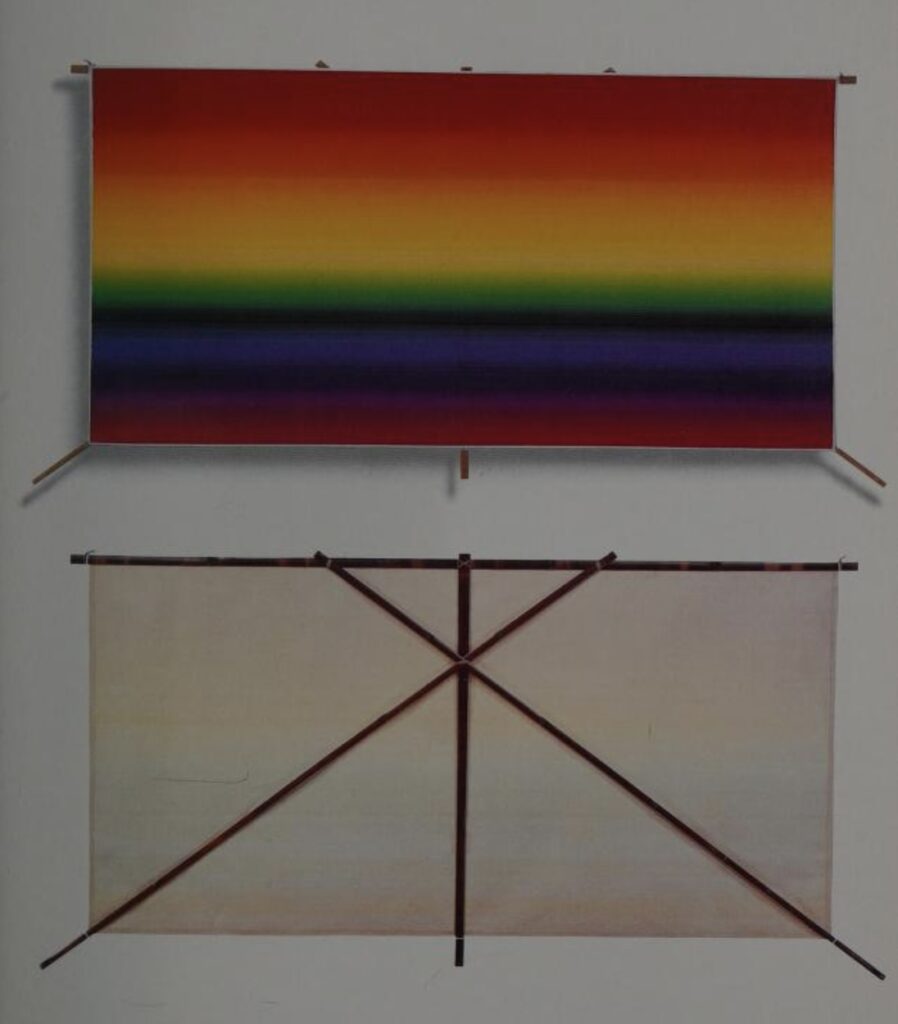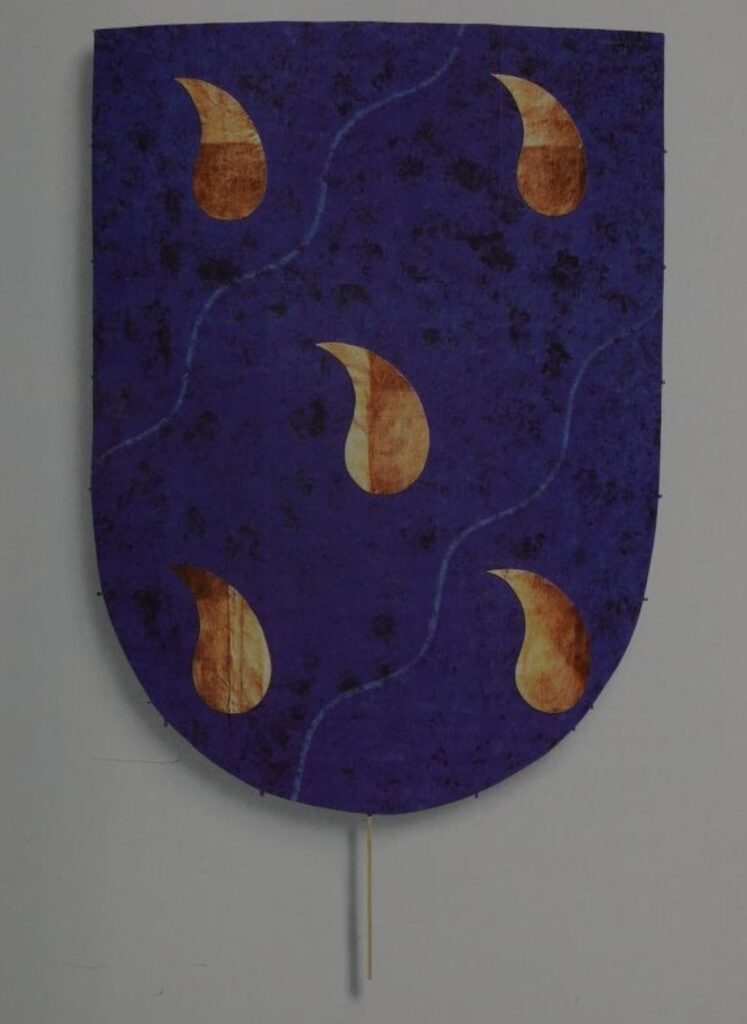
Sky House I, meanwhile, Rauschenberg kept for himself, according to former assistant Thomas Buehler
Robert Rauschenberg’s genius in making a 20×10-foot Art Kite was in understanding the opportunity while ignoring the assignment. Because the opportunity was to make two Art Kites, and have your Art Kites fly in the “vernissage in the sky” at an Art Kite Festival held amidst the blossoming sakura on the grounds of Himeji Castle. While the assignment was to promote Lufthansa.

Obviously, it was more than that, but also just that. The Art Kites Project was sponsored by Lufthansa and organized by Dr. Paul Eubel, director of the Goethe Institute Osaka, which commissioned 100 artists from around the white world and Japan to create Japanese-style kites in 1987. The kites would fly once in Japan, on April 1 & 2, 1989, and once in Europe, on April 21 & 22, 1990, go on tour for three five years, to 21 museums in Japan (8), Europe (12), and Canada (1), before being auctioned off.
Here are just a couple of the swerves from the first and last paragraphs of Goethe President Klaus von Bismark’s introduction to the AKP, from Pictures For The Sky, the exhibition catalogue first published in 1991. It is available to borrow from the Internet Archive.
It is a curious fact that, even as new material technology makes it ever easier for humans to frolic and soar among the clouds, our ages-old fascination with flying shows no signs of diminishing. In fact, one is hard-pressed to find many inhabitants of this planet so fond of gravity that their souls don’t quiver at the merest suggestion of free, bird-like flight.
The same situation applies to fine art…
…
A final note. At the conclusion of a three-year world tour of major museums, the Art Kite collection will be auctioned off with the proceeds going to the United Nations Disaster Relief Fund. It is tragic irony that the same sky that offers so much beauty and amusement also occasionally brings tragedy—as it did to Hiroshima, for example, not far from the site of the Art Kites’ Japanese vernissage in the sky.
Which, let’s bookmark this and come back to it.

The catalogue dates and venues do not quite line up with those of the Art Kite-related exhibition history of another still-famous artist in the Project, Gerhard Richter. Though all artists were invited, is also not clear whether Richter attended the Tokyo vernissage. [Rauschenberg sure did, virile young assistants in tow.] The 160 x 160 cm square Hamamatsu-style kite of acrylic on washi does not appear in Richter’s CR, nor in Atlas.

The other 98 artists on Art Kites Project’s list are a mix of mhm, huh! and who? Atsuko Tanaka’s kite may have just been a whole-ass painting on canvas, lashed to some bamboo, and flung in the air.

Ay-O’s Buka-style kite, meanwhile, was not only a 96-strata rainbow gradient silkscreen on washi, it had an awesome pared down kite structure, just a T and an X.

Though they had a TV test pattern motif painted onto a few hundred sushi platters and ready to go in Tokyo, General Idea eschewed the synergy. Instead, the Canadian throuple made a kite in the shape of an heraldic shield, with a golden shower of…fine, the sponsor says they’re “trickling down like bitter tears.” So tears it is!

The flyaway winner, though, has to be sculptor Yoshio Kitayama, who spent more than a decade before Dr. Eubel called making impossibly complex structures of bamboo, paper, and wire. Kitayama’s mobiles balanced like a Calder, while seeming to trace the motions of a Calder in X-Y-Z gridspace.
It was only while researching General Idea’s heraldic phase that I learned their kite, Far Cry, surfaced at auction in 2022, where it sold for €13.000, a world record for a piss-themed kite. But this was not a resale. Stuttgart-based auctionhaus Nagel was psyched to announce the sale of the entire global Art Kites Collection, 145 kites commissioned—and collected—by Dr. Paul Eubel. “In July 2010, Dr. Eubel passed away in Palermo, Sicily. He bequeathed the Collection to his wife and their two children. For a long time, the works on paper were stored and untouched in a warehouse. After more than 35 years, the entire Collection is now accessible in the art market and auctioned by NAGEL Auktionen.
“In the spirit of the original project idea, part of the auction’s proceeds will benefit worldwide disaster reliefs and aid.”
Hmm! Filling in a little history here, Eubel commissioned additional kites at exhibition venues along the way, then put the whole thing on view from 1999 through 2005 at an aircraft hangar near the 2000 World Expo in Hannover.
Somewhere along the way, enough Lufthansa executives turned over, enough culture ministry workers got busy with reunification, and enough artists who thought they were donating artworks to UN disaster relief died to make “Somehow the collection is mine” the Art Kites equivalent of “Somehow, Palpatine has returned.”
The kites began at Lot 1000. Rauschenberg’s kite sold for EUR440,000; Richter’s was EUR280,000, not bad for Richter’s only acrylic—and a thing that isn’t in the CR. The highest price was for Kazuo Shiraga’s kite, which sold for EUR1.14 million. All in, the Art Kites sold for EUR5.7million, netting the Eubel heirs up to EUR3.7 million.
Nice work if you can get it. And in one soaring, freespending moment of West German cultural rehabilitation and Japanese postwar cultural ascendance, Goethe and Lufthansa did. And after they’d wrung the publicity value out of it, and Germany reunified, and Japan’s bubble popped, and no one gaf what happened to the art kites, or UN disaster recovery victims, they cut it loose. Whether Eubel was left to pick up the pieces after the crash, or he was pulling the strings all along, I can’t tell.
